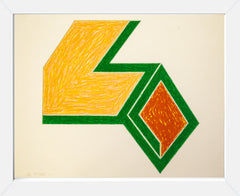
| Current Frank Stella Inventory | Recent Frank Stella Sales |

Frank Stella - Artworks for Sale

Frank Stella: Redefining Abstraction Across Six Decades
Frank Stella was an American painter, printmaker, and sculptor whose career spanned more than six decades and significantly shaped the course of postwar art. Emerging at the end of the 1950s, Stella became a central figure in the transition from Abstract Expressionism to Minimalism and helped redefine the possibilities of abstract painting and three-dimensional form.
Stella was born in Malden, Massachusetts, in 1936. He studied history at Princeton University, where he was introduced to modernist painting through his professors and classmates, and through visits to New York galleries. After graduating in 1958, he moved to New York City, where he encountered the prevailing dominance of Abstract Expressionism. Rejecting the gestural intensity and personal symbolism of artists such as Jackson Pollock and Willem de Kooning, Stella developed a radically different approach, emphasizing flatness, clarity, and the literal qualities of painting.
His breakthrough came in 1959 with the Black Paintings, a series of canvases composed of symmetrical, repeated bands of black paint separated by thin lines of unpainted canvas. Exhibited at the Museum of Modern Art in the landmark 1959 exhibition Sixteen Americans, these works marked a decisive break from the emotive qualities of the preceding generation and became foundational to Minimalist aesthetics. Stella's often-cited statement, “What you see is what you see,” underscored his commitment to an art stripped of illusionism and external reference.
During the 1960s, Stella expanded his formal vocabulary through his shaped canvases, in which the canvas itself departed from the conventional rectangle. These works, such as the Protractor Series (1967–71), employed vibrant color and complex geometric arrangements, reinforcing painting as a physical object rather than a window into pictorial space. His interest in extending painting into the realm of the three-dimensional grew in the 1970s and 1980s, when he created increasingly elaborate constructions that blurred distinctions between painting, relief, and sculpture.
In addition to his work in painting and sculpture, Stella became a prolific printmaker. He collaborated with several leading print workshops, producing large-scale, technically innovative works that further explored his engagement with color, form, and spatial complexity. His Moby-Dick series (1980s–1990s), comprising both prints and sculptural reliefs, exemplified this period of experimentation, combining references to literature with highly dynamic abstract forms.
Stella's career was recognized with numerous honors, including a retrospective at the Museum of Modern Art in 1970, when he was only 34 years old, and a second major retrospective in 1987. He represented the United States at the Venice Biennale in 1984, and his work is held in the permanent collections of leading institutions worldwide.
Frank Stella's legacy rests on his ability to transform the language of abstraction across multiple media. His insistence on the autonomy of the artwork, his expansion of painting into shaped and three-dimensional forms, and his continual reinvention of formal strategies ensured his position as one of the most influential figures in modern and contemporary art.
Subscribe to our newsletter to get an instant alert when we add the next piece by Frank Stella
| Current Frank Stella Inventory | Recent Frank Stella Sales |